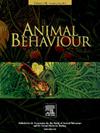探讨水平病原体传播对合作繁殖蜘蛛死亡率和行为的影响
IF 2.3
2区 生物学
Q2 BEHAVIORAL SCIENCES
引用次数: 0
摘要
在动物社会中,社会互动是疾病爆发背后的推动力量。随着群体变得更加复杂并建立永久性巢穴,它们冒着引入更多潜在病原体暴露途径的风险。社会社会拥有公认的“超有机体免疫力”,可以预防疾病。然而,对合作繁殖者的社会免疫进行调查的研究较少,这可能有助于深入了解在社会性重大进化转变期间,免疫作为一种集体行为形式的演变。我们将群居蜘蛛(Stegodyphus dumicola)暴露于一种通用昆虫病原真菌(robert Metarhizium)下,使用三种暴露模式:直接暴露在群体伴侣上,通过猎物和巢穴暴露机械传播。我们比较了暴露组和无病原体对照组之间的蜘蛛死亡率。我们测量了空间利用和群体破碎度,以测试病原体暴露途径和疾病严重程度是否影响蜘蛛的聚集和一夫多妻行为。我们发现,暴露途径对蜘蛛的死亡率有很大影响,直接暴露导致蜘蛛的死亡率最快。与所有其他处理方法相比,直接暴露蜘蛛的组中的个体也更有可能在巢外被观察到。暴露对蜂群破碎性没有影响。这些数据表明,病原体的传入途径不仅影响疾病暴发的严重程度,而且可以改变与社会免疫有关的行为。本研究增强了我们对合作育种者之间社会免疫的过渡步骤的理解,这可能导致超个体免疫的进化。本文章由计算机程序翻译,如有差异,请以英文原文为准。
Exploring the effects of horizontal pathogen transmission on mortality and behaviour in a cooperatively breeding spider
Social interactions are a driving force behind disease outbreaks in animal societies. As groups become more complex and build permanent nests, they run the risk of introducing more routes of potential pathogen exposure. Eusocial societies have well-established ‘superorganism immunity’ that protects against disease. However, fewer studies have investigated social immunity in cooperative breeders, which may provide insight into the evolution of immunity as a form of collective behaviour during major evolutionary transitions in sociality. We exposed groups of social spiders (Stegodyphus dumicola) to a generalist entomopathogenic fungus (Metarhizium robertsii) using three modes of exposure: directly onto a groupmate, mechanically vectored by prey and nest exposure. We compared spider mortality between exposed groups and pathogen-free controls. We measured space use and colony fragmentation to test whether pathogen exposure route and disease severity affected spiders' aggregation and polydomy behaviour. We found that route of exposure greatly affected spider mortality, with direct exposure resulting in the most rapid mortality. Individuals from groups with a directly exposed spider were also more likely to be observed outside their nest compared to all other treatments. Exposure did not result in differences in colony fragmentation. These data demonstrate that the route of pathogen introduction not only affects the severity of disease outbreaks but can also alter behaviours relevant for social immunity. This study enhances our understanding of the transitional steps in social immunity among cooperative breeders that may lead to the evolution of superorganism immunity.
求助全文
通过发布文献求助,成功后即可免费获取论文全文。
去求助
来源期刊

Animal Behaviour
生物-动物学
CiteScore
4.60
自引率
8.00%
发文量
236
审稿时长
10.2 weeks
期刊介绍:
Growing interest in behavioural biology and the international reputation of Animal Behaviour prompted an expansion to monthly publication in 1989. Animal Behaviour continues to be the journal of choice for biologists, ethologists, psychologists, physiologists, and veterinarians with an interest in the subject.
 求助内容:
求助内容: 应助结果提醒方式:
应助结果提醒方式:


